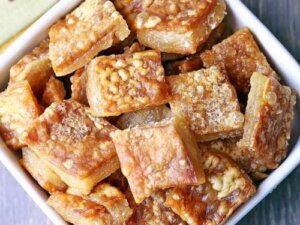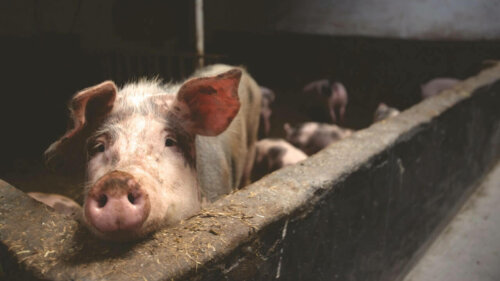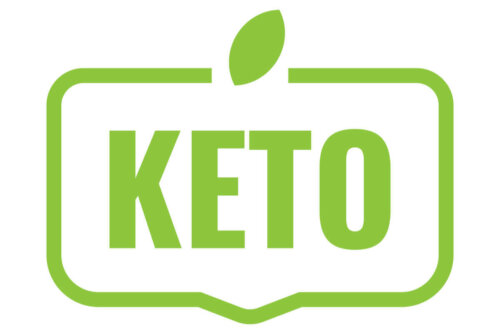The Benefits and Risks of Eating Pork Rinds


Written and verified by the nutritionist Saúl Sánchez Arias
Pork rinds are a very common food. Although they’re not popular everywhere, they do have an interesting nutritional value. This food is also common in eastern European markets, where it’s a delicacy. Today, we’re going to focus on the benefits and risks associated with eating pork rinds.
How are pork rinds prepared?
To make pork rinds, they usually fry the pork. They use practically every part of the pig to make them.
Once they’ve fried them, they will serve them as either a single dish or as a side with other dishes. Usually, people eat them as an appetizer, but some people like to eat them as a snack between meals. As you can probably guess, they’re very calorie-dense.
Nutritional value
Like we previously mentioned, since pork rinds are a fried good, their caloric value is very high. For every 100 grams of it, you’ll be consuming 544 calories.
Therefore, you have to be careful when eating them, since eating more calories than your body expends will cause you to gain weight. And, weight gain can negatively affect your overall health.
In addition, when it comes to macronutrients, pork rinds have a significant concentration of fat. They have 31 grams of fat per 100 grams. However, it also contains a good amount of protein.
As far as micronutrients are concerned, it’s worth noting that pork rinds contain vitamins A and B. Also, it contains calcium, magnesium, and iron.

Keep reading: How Much Protein Should I Take if I Exercise?
Possible health benefits associated with eating pork rinds
Now, we’re going to take a look at the possible health benefits of pork rinds, as well as what science says about this food.
Lowered risk of developing anemia
Anemia is a pathology caused by an iron deficiency. This condition causes chronic fatigue due to an inefficient supply of oxygen at the cellular level.
According to The Medical Clinics of North America, regular iron consumption reduces the risk of developing this disease.
Improved muscle help
The proteins in pork rinds have a high biological value and are easily digestible. Therefore, they contain quality proteins that can help to improve your muscle health.
Therefore, eating pork rinds can contribute to developing the hypertrophy process and can help repair your muscles.
Possible risks associated with eating pork rinds
The greatest risk associated with eating pork rinds has to do with how they are cooked. Although eating saturated fats and dietary cholesterol isn’t a relevant health problem, trans-fatty lipids are.
You should keep in mind that pork rinds are almost always fried. This process causes a change in the spatial arrangement of fats, making them go from cis to trans configuration. According to research published in the journal Diabetes & Metabolic Syndrome, regularly consuming these fats can increase your risk of developing chronic diseases.
Also read: Fats in Foods: Unsaturated Fats over Saturated or Trans Fats?
The popularity of the keto diet
Because of its high nutritional density, people who are following keto diets tend to include pork rinds in their diets.
Remember, the proteins in this food do have a high biological value.
This food’s makeup helps to satiate hunger, so it can help you stick to various types of diets. However, there are still many risks of eating pork rinds, especially in the medium and long term. Again, this is because of the frying method.

The recommended way to eat pork rinds
Although we don’t recommend frying the pigskin, other alternative cooking methods can make it healthier.
Of course, those alternatives won’t create the same crunchy and greasy surface, but it’s much better for your health. In addition, it’s possible to find some recipes that have you stew the pork or cook it at a low temperature. Both of these options will give you a much higher quality dish.
Conclusion
As you can see, pork rinds are a common food in certain areas and it has a high caloric density.
If you love this food but are concerned about the risks associated with eating pork rinds, it’s best to opt for a less aggressive cooking method than frying. That way, you’ll be able to enjoy a dish with a lower percentage of trans fatty acids.
All cited sources were thoroughly reviewed by our team to ensure their quality, reliability, currency, and validity. The bibliography of this article was considered reliable and of academic or scientific accuracy.
- Ortega FB, Lavie CJ, Blair SN. Obesity and Cardiovascular Disease. Circ Res. 2016 May 27;118(11):1752-70. doi: 10.1161/CIRCRESAHA.115.306883. PMID: 27230640.
- DeLoughery TG. Iron Deficiency Anemia. Med Clin North Am. 2017 Mar;101(2):319-332. doi: 10.1016/j.mcna.2016.09.004. Epub 2016 Dec 8. PMID: 28189173.
- Islam MA, Amin MN, Siddiqui SA, Hossain MP, Sultana F, Kabir MR. Trans fatty acids and lipid profile: A serious risk factor to cardiovascular disease, cancer and diabetes. Diabetes Metab Syndr. 2019 Mar-Apr;13(2):1643-1647. doi: 10.1016/j.dsx.2019.03.033. Epub 2019 Mar 16. PMID: 31336535.
This text is provided for informational purposes only and does not replace consultation with a professional. If in doubt, consult your specialist.








